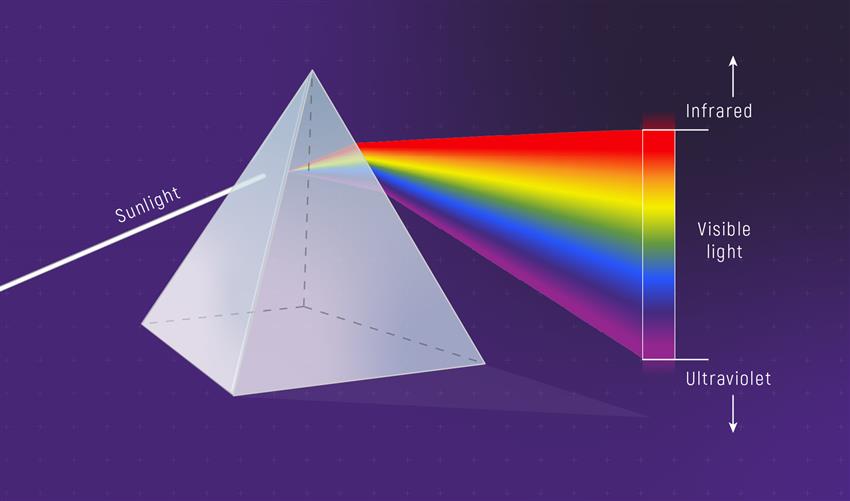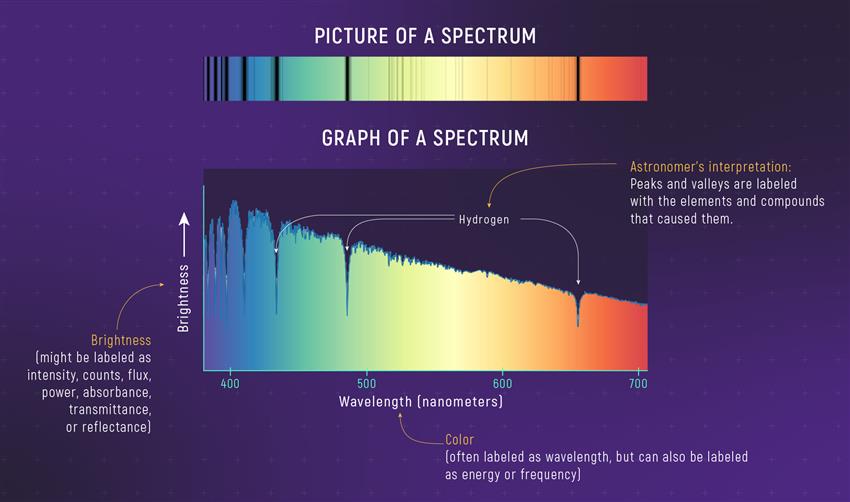What is spectroscopy?
Most people have seen beautiful pictures of galaxies, fields of stars, and nebulae taken by telescopes on Earth and in space. Beyond displaying breathtaking views of the universe, these images enable scientists to perform lots of great science.
But images are not the only type of scientific data that can be captured by telescopes. A very common technique called spectroscopy captures a type of data called a spectrum (plural: spectra). Astronomers can discover many more characteristics about celestial objects through spectroscopy. In fact, about 75% of all data collected by the James Webb Space Telescope is spectra.
If a picture is worth a thousand words, astronomers believe that a spectrum is worth a thousand pictures!
What is a spectrum?
A continuous spectrum refers to all types of electromagnetic energy gathered from a celestial object. For example, the white light of a star like the Sun can be broken down to reveal the visible part of the spectrum: the rainbow of colours that it is composed of. A light's spectrum can also include energy that is not visible to the human eye, like gamma rays, X-rays, ultraviolet rays, infrared, microwave and radio waves.
How does spectroscopy work?
In order to gather and record the spectrum of a light source, it is necessary to break the light apart. For example, a glass prism can be used to separate the white light of the Sun. By separating the differently coloured rays of light, the prism creates a neatly ordered rainbow of colours that make up the Sun's visible light spectrum.

Text version - Sunlight broken down by a prism - infographic
A glass prism separates sunlight into all its colours to create a rainbow, which is a spectrum of its visible light. Sunlight also contains invisible kinds of light, like ultraviolet and infrared light, which are parts of the spectrum as well. Raindrops can also act as a prism. When the Sun appears at the same time as, or shortly after, a rainfall, raindrops will separate, or disperse, sunlight into a rainbow in the sky. (Credit: NASA/ESA/L. Hustak [STScI])
Scientists use prisms and other instruments that work in similar ways to split the light from distant celestial objects to understand them more deeply. This process of separating light into its smaller components can be done with all kinds of light.
Instruments called spectrographs on the Webb Telescope, like Canada's NIRISS, contain grisms, a specialized type of prism that can break apart infrared light, which is invisible to the human eye. These instruments can thus create infrared spectra, and measure the amounts of light in various parts of them.
A basic principle of spectroscopy is that colour and light carry information. Studying the way that different wavelengths of light interact with different types of matter can reveal many of its characteristics, including temperature, composition, and motion. Some of these details are revealed by studying the parts of the light that have been absorbed by a planet's or a star's atmosphere and are therefore "missing
" from the spectra collected.
What is spectroscopy used for?
To determine the temperature of a star
A spectrum emitted by a hot, dense light source such as a star shows up as a nearly continuous rainbow. This spectrum can also extend to invisible kinds of light such as ultraviolet or infrared light. The intensity of the rainbow across its different colours or its different wavelengths will depend on the temperature of the light source. For example, hotter stars will peak closer to blue light, and colder stars will peak closer to red light. By determining at which wavelength an object's spectrum is brightest, astronomers can estimate the temperature of objects hundreds and even millions of light-years away.
To read the light of celestial objects through "cosmic barcodes
"
As light from the core of a star travels through space, it can also pass through that star's atmosphere, atmospheres of distant planets or clouds of gas. When this happens, molecules and atoms found within these objects and regions can absorb very specific colours or wavelengths of light. The light that emerges, or makes it past these obstacles, forms an absorption spectrum, which looks like a rainbow with dark lines scattered across it.

Text version - The visible light spectrum of the star Altair - infographic
This is the visible light spectrum of the star Altair, which lies about 16.7 light-years from Earth. The picture of the spectrum (top) appears as a nearly continuous rainbow with a few dark lines representing light that has been absorbed by hydrogen found in the star's atmosphere. Astronomers can turn this spectrum into a graph (bottom) that shows how bright the star is at different wavelengths, or colours. The hydrogen absorption lines are still visible here as dips in the star's brightness at specific wavelengths. (Credit: NASA/ESA/L. Hustak [STScI])
The position of these lines, which look like a cosmic barcode, tells us which molecules and atoms are in the gas that absorbed parts of the light. This is how astronomers determine the chemical composition of celestial objects, which can help determine the habitability of a distant exoplanet or the age of some of the oldest galaxies, whose light has greatly shifted into the infrared part of the spectrum.
NIRISS: Canada's spectrograph on the Webb Telescope
Armed with its many spectrographs, including the Canadian-made Near Infrared Imager and Slitless Spectrograph (NIRISS), the Webb Telescope is helping unveil many of our universe's mysteries.
Thanks to its observational modes, NIRISS is particularly suited to different types of important observations:
- Gathering high-precision, medium-resolution spectra from one bright object at a time, suited for studying exoplanets as they transit their host star
- Collecting low-resolution spectra from thousands of objects at a time, suited for studying vast fields of hundreds or thousands of distant galaxies
Using the Webb Telescope, Canadian scientists and researchers around the world will be able to determine if distant planets could be habitable based on whether or not their spectra show lines associated with certain molecules like water, carbon dioxide, methane and oxygen in their atmospheres.
